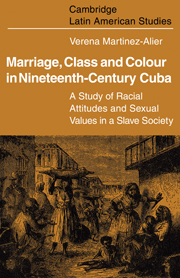 Marriage, Class and Colour in Nineteenth Century Cuba
Marriage, Class and Colour in Nineteenth Century Cuba I shall be concerned primarily with marriage as a focal point for an assessment of nineteenth-century Cuban society. Yet, rather than taking the normal events as a basis for investigation, I have used the well-documented deviations from the norm as provided in the administrative and judicial proceedings of cases where parents oppose a given marriage, of cases where this opposition is overcome by means of elopement, and of cases of interracial marriage. These deviations from ideal behaviour, while by no means everyday occurrences, nevertheless highlight the conflicts obtaining in the system and make its norms all the more apparent.
From the dominant sector's point of view, marriage in nineteenth-century Cuba was ideally isogamic, i.e. like married like. In 1776 the enlightened Charles III had passed the Royal Pragmatic on marriage which by severely restricting freedom of marriage lent legal support to the aspirations of social exclusiveness. While surely most sons and daughters followed the dictates of their elders in their choice of spouse, nevertheless there were also instances where this was not so. These dissidents had two paths open to them. They could either appeal to the authorities to have parental dissent overruled, or they could resort to elopement. In the latter case, the ensuing dishonour of the daughter often compelled parents to reconsider their posture and grant their approval after all. Yet, certain limits were set to the effectiveness of the elopement. When the social distance between the partners exceeded the tolerated maximum, considerations of family prestige came to prevail over the regard for a daughter's moral integrity.
To save this book to your Kindle, first ensure [email protected] is added to your Approved Personal Document E-mail List under your Personal Document Settings on the Manage Your Content and Devices page of your Amazon account. Then enter the ‘name’ part of your Kindle email address below. Find out more about saving to your Kindle.
Note you can select to save to either the @free.kindle.com or @kindle.com variations. ‘@free.kindle.com’ emails are free but can only be saved to your device when it is connected to wi-fi. ‘@kindle.com’ emails can be delivered even when you are not connected to wi-fi, but note that service fees apply.
Find out more about the Kindle Personal Document Service.
To save content items to your account, please confirm that you agree to abide by our usage policies. If this is the first time you use this feature, you will be asked to authorise Cambridge Core to connect with your account. Find out more about saving content to Dropbox.
To save content items to your account, please confirm that you agree to abide by our usage policies. If this is the first time you use this feature, you will be asked to authorise Cambridge Core to connect with your account. Find out more about saving content to Google Drive.